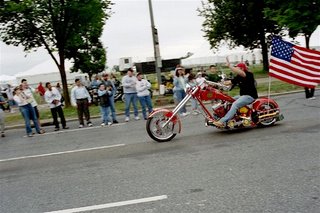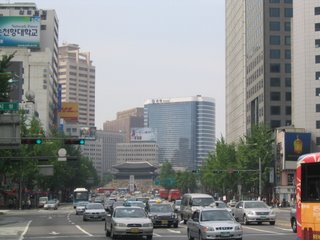


This week-end, we celebrate Memorial Day. It is like May 8 and November 11 rolled into one. Here, in the US, we do not have as many days off in May as in Europe (Ascension Day, Pentecost Day, Europe Day, May Day), which, in a good year, if strategically placed, give you practically a month off.
Here, we celebrate the fallen heroes of all wars, starting with The war between the States, or as it is called in Virginia, "the wah!"
There are many celebrations. It is the first day of official summer. All swimming pools reopen. The President, a fine warrior himself, makes a speech at the Tomb of the Unknown Soldier.
All roads are clogged with traffic, as many, in spite of outrareous gas prices, hit the asphalt to go to the Atlantic Beaches, or the cool Blue Ridge Mountains.
The temperature has hit 90F (32C), as on cue.
But the biggest event, bigger than the obligatory backyard barbecue, is Rolling Thunder.
Back in the 80s', there were parades honoring the veterans of WWI, WWII, and Korea. In 1987, uninvited, a couple of hundred Vietnam war veterans joined the back of the parade mostly mounted on Harley Davidsons. I witnessed the event, and the acclamations that accompanied the bearded, pot-bellied riders , told me they were on to something.
Today, Vietnam vets, and their friends, converge from all over the US to the Vietnam Wall in DC. For days before the event, you hear the sweet rumble of shovelheads, and every motel in the area is surrounded by US iron.
Then, on Memorial Day Sunday, at noon, the parade of over 500,000 motorbikes starts from the Pentagon parking lot, over Memorial bridge, past the Vietnam monument and around the mall. The ride-past lasts the entire afternoon. Later, greybeard veterans dismount and descend along the black marble wall in search of their lost brother"s names. There is not a dry eye in the crowd.
Is it because we share the same generation, or because it is a day to reflect upon the inanity of war? I always feel a big knot in my throat.













